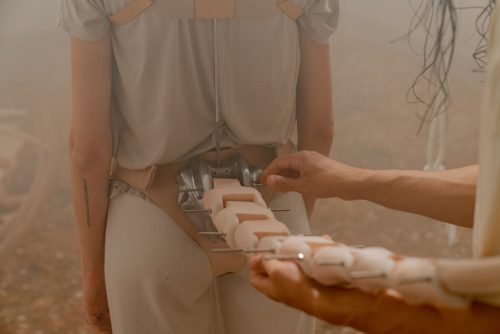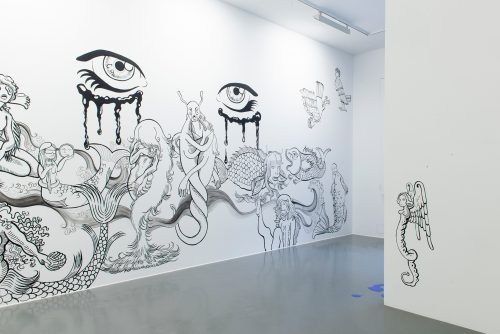
Andria Dolidze, Amelie Karweick, Ming Yuan, Moreno Schweikle, Paola Siri Renard, Ja Jess & Jessica Tille
In Between Transit
Project Info
- 💙 Kadel Willborn
- 💚 Kim-Camille Kreuz
- 🖤 Andria Dolidze, Amelie Karweick, Ming Yuan, Moreno Schweikle, Paola Siri Renard, Ja Jess & Jessica Tille
- 💛 Simon Vogel
Share on

Installation view: "In Between Transit", curated by Kim-Camille Kreuz, Kadel Willborn, Düsseldorf, 2025
Advertisement

Installation view: "In Between Transit", curated by Kim-Camille Kreuz, Kadel Willborn, Düsseldorf, 2025

Installation view: "In Between Transit", curated by Kim-Camille Kreuz, Kadel Willborn, Düsseldorf, 2025

Installation view: "In Between Transit", curated by Kim-Camille Kreuz, Kadel Willborn, Düsseldorf, 2025

Installation view: "In Between Transit", curated by Kim-Camille Kreuz, Kadel Willborn, Düsseldorf, 2025
In a time when signs, spaces, and materials are in constant circulation, meanings continuously shift and transform. The exhibition brings together seven artistic positions that engage with the fragmentation, recontextualization, and reordering of urban, technological, and narrative structures. Andria Dolidze, Amelie Karweick, Moreno Schweikle, Paola Siri Renard, Ming Yuan, Jessica Tille, and Ja Jess share an interest in hybrid spaces, transitional states, and the boundaries between materiality and imagination. Through their method, they move between archive and present, disruption and assemblage. Their works engage with each other in the space, creating a dialogue about the construction of reality in a world where boundaries – such as between text and image, object and function – are becoming increasingly fluid. The curatorial concept of the exhibition emerges from a dual perspective: Kim-Camille Kreuz combines her own artistic practice with a curatorial approach that is concerned with processes of translation and reorganization, as well as with the concepts of surrogate, supplement, and reproduction.
Andria Dolidze’s painterly practice draws from found urban material: fragmented texts, images, stickers, writings, architectural details, and ornaments are deconstructed, layered, and reconfigured. In a play between opacity and transparency, his works create visual texts that reflect the heterogeneity of urban space and decentralize its visual language. Through dissection, fragmentation, and transformation, the artist generates new narratives.
The monochrome drawings by Amelie Karweick shown in the exhibition evoke flattened reliefs. In line with her sculptural thinking, Karweick approaches paper as a rough surface into which the graphite-clay mixture of a pencil can be worked—light and shadow become formative elements. Her interest lies less in the realistic depiction of an object than in evoking its sculptural presence. Representation here is understood not as a mimetic act, but as an open process—open also in the sense that form is not defined by bounding lines, but solely through precisely modulated contrasts. As in her sculptures, the drawings move between construction and erosion, between the tectonic and the ephemeral.
Moreno Schweikle explores the manipulation of form, function, and often the functional values of objects to decipher their inherent context and juxtapose old and new meanings. His sculptural and site-specific installations examine the constant influence of technology on everyday objects, leading to a hybrid production that integrates both the handmade and the machine-made.
Paola Siri Renard’s artistic practice moves between Western architecture, natural processes, and collective imaginations. By appropriating dominant architectural archives and defense narratives, her sculptures explore transitional metamorphoses—bodies dissolving and transforming into fictional constellations. She designs her installations as instruments of displacement, shifting between centuries, worlds, and their myths. Renard’s handcrafted works challenge the handling of heritage, its dissemination, and the exclusionary foundations of certain identities—while reflecting the history of her Martinican and Swedish heritage.
Ming Yuan is working with painting, sculpture, sound, and essay. Her practice explores how ideology and morality take form, shaped by her diasporic experience of class, race, and gender. Using iconography, pattern, and symbolism, she examines shifting ideas of identity and power. Tensions between ornament and minimalism, rebellion and conformity run through her work, where frames and surfaces become sites of contradiction. Drawing on rituals, packaging aesthetics, and class memory, she treats visual language as a space where personal and economic histories collide. Her recent series on gift boxes explores the moral paradoxes of the gift economy and class-coded aesthetics.
Jessica Tille dissects the potential of spatial narration between text, book, and body. Her time-based works take shape at the interfaces of media, questioning the temporality and rhythm of technical and organic systems. She is interested in how versions of truth and fiction are modulated from a single source of information. In her series Durational Prosthetics, the production of text is tied to a temporally and spatially defined framework that projects a bodily experience within the con_text. Through the embodiment of technology via language and as sub_text, the body becomes a time-based biographical medium that carries both material and immaterial traces.
Ja Jess’s practice develops from performative research through the adoption of collective societal roles, situated within context-based social interdependence. These roles are scripted into text bodies, which are documented theatrically and deconstructed, then expanded phantasmagorically. As shaping glitches between fiction and physical presence, they open a discourse on the body as a resource for identity construction and its landscaping within socially archived realities.




